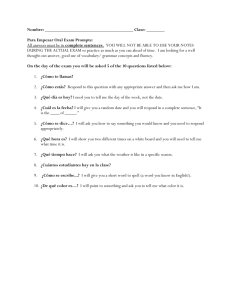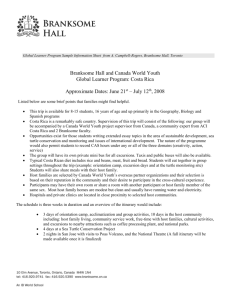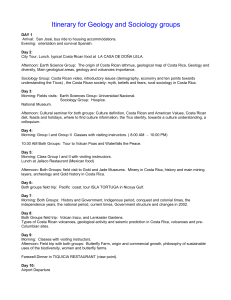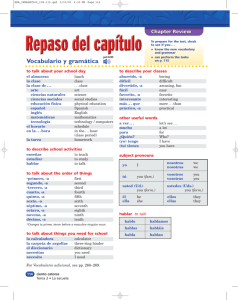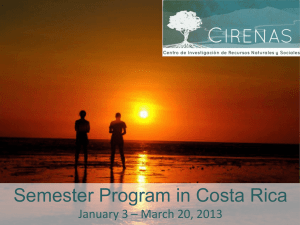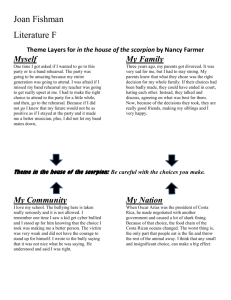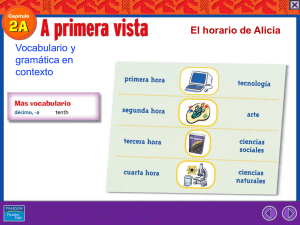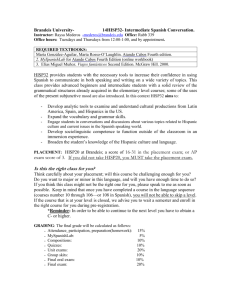Word Document
advertisement
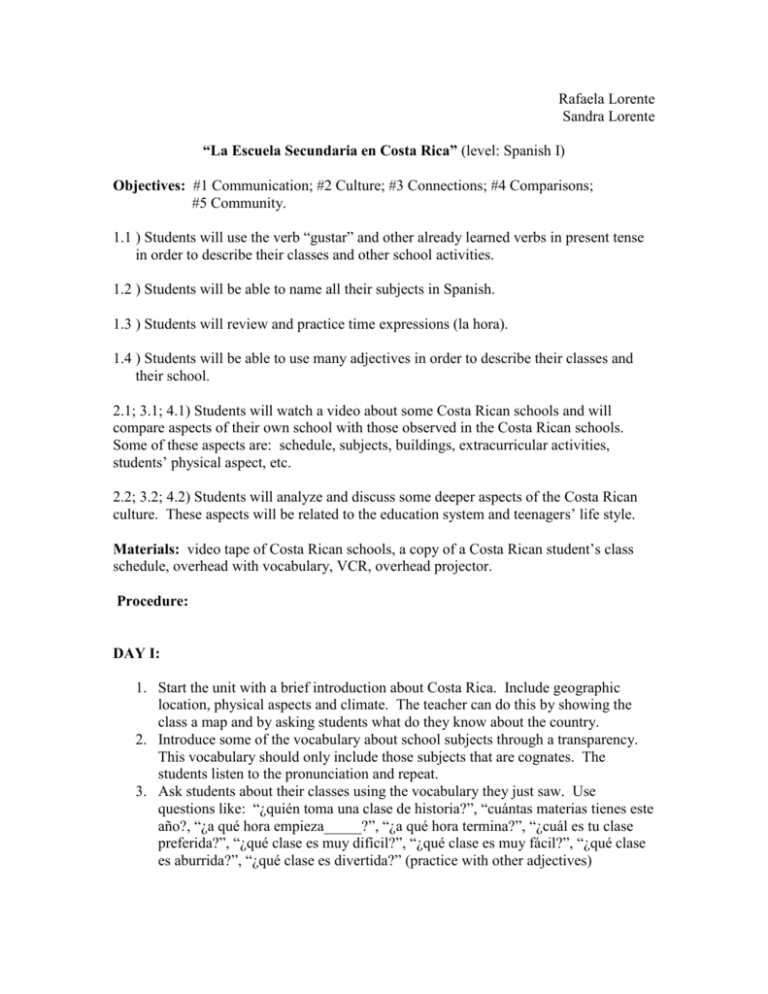
Rafaela Lorente Sandra Lorente “La Escuela Secundaria en Costa Rica” (level: Spanish I) Objectives: #1 Communication; #2 Culture; #3 Connections; #4 Comparisons; #5 Community. 1.1 ) Students will use the verb “gustar” and other already learned verbs in present tense in order to describe their classes and other school activities. 1.2 ) Students will be able to name all their subjects in Spanish. 1.3 ) Students will review and practice time expressions (la hora). 1.4 ) Students will be able to use many adjectives in order to describe their classes and their school. 2.1; 3.1; 4.1) Students will watch a video about some Costa Rican schools and will compare aspects of their own school with those observed in the Costa Rican schools. Some of these aspects are: schedule, subjects, buildings, extracurricular activities, students’ physical aspect, etc. 2.2; 3.2; 4.2) Students will analyze and discuss some deeper aspects of the Costa Rican culture. These aspects will be related to the education system and teenagers’ life style. Materials: video tape of Costa Rican schools, a copy of a Costa Rican student’s class schedule, overhead with vocabulary, VCR, overhead projector. Procedure: DAY I: 1. Start the unit with a brief introduction about Costa Rica. Include geographic location, physical aspects and climate. The teacher can do this by showing the class a map and by asking students what do they know about the country. 2. Introduce some of the vocabulary about school subjects through a transparency. This vocabulary should only include those subjects that are cognates. The students listen to the pronunciation and repeat. 3. Ask students about their classes using the vocabulary they just saw. Use questions like: “¿quién toma una clase de historia?”, “cuántas materias tienes este año?, “¿a qué hora empieza_____?”, “¿a qué hora termina?”, “¿cuál es tu clase preferida?”, “¿qué clase es muy difícil?”, “¿qué clase es muy fácil?”, “¿qué clase es aburrida?”, “¿qué clase es divertida?” (practice with other adjectives) 4. Show a transparency with the schedule of a Costa Rican student and ask questions (e.g. “¿cómo se llama este estudiante?”, “¿cuántas clases toma?”, “¿a qué hora empieza…?”). Start drawing attention to the subjects that are not cognates. Try to use these words more often when asking students. 5. Pair activity: the students work in pairs and ask their classmate questions in order to draw his/her schedule. The teacher can write some examples of questions on the board. To evaluate, ask a few students questions about their classmate’s schedule. DAY II: 1. Warm- up/ review: ask students some questions about their classes like the day before in order to review what they have seen. 2. Attention point: when asking students about their classes, start asking them what do they need for certain classes. E.g. ¿qué se necesita para la clase de matemáticas?, ¿necesitas un lápiz?, ¿necesitas un cuaderno de dibujo?, etc. (help students with the vocabulary by asking “yes/no” and “or” questions) 3. Activity with school supplies 4. Grammar explanation: GUSTAR. Teacher will draw a smile face on the left side of the board and under it will write sentences like “Me gusta la clase de historia”; “Me gustan los deportes” “A Sandra le gustan los estudiantes de la clase” “A nosotros nos gusta la profesora” etc. making sure to cover all the pronouns (te, le(s)..). On the other side ob board, the teacher writes a sad face and write s few examples with negative statements (“No me gusta estudiar”). Teacher ask a few students if they like certain things (example: Cristina, ¿te gusta la clase de álgebra?”, “John, ¿qué dos clases no te gustan?”When finished, ask the class about the students’ answer ““qué clases no le gustan a John?” After making sure, that all the pronouns have been covered, teacher asks students questions like “What are the pronoun uses for él o ella?, Where does the no go when expressing dislikes, what are the two possible endings of gustar and how do we use them”. Teacher gives then a gramatical explanation. 5. On board, the teacher writes a list of activities and things, ask students to get in pairs and to alternate asking each other wether they like those things. At the end each student will write five complete sentences about their partner’s likes and dislikes ( “A Joe le gustan las hamburguesas”) DAY III: 1. Los deportes y otras actividades: Introducción de vocabulario. Teacher will show pictures with people practicing different sports (playing basketball, football, etc) and other activities (hablar por teléfono, tocar la guitarra, etc) 2. Reading : Una carta de una estudiante costarricense. Teacher will call on different students to read the letter aloud. 3. Questions about the reading. Students will work with a partner and prepare answers to 8 questions about the letter. This will be done orally. Then, teacher will use ask different students for the answers. At this point, teacher can add other questions (ex: ¿y por qué le gusta la clase de inglés? ¿cómo es el profesor de la clase?). 4. Students get with partner again to discuus about their clases and acitvities 5. Teacher and students will discuss differences found between the Costa Rican schedule and vacation. a) Students have more classes. Teacher explains that they don’t have the same classes every day as students in the USA do. b)Costa Ricans have their longest vacation during December because it’s the summer there. DAY IV: 1. Show a video about Costa Rican schools and students. Ask students what differences they noticed in the video: (1) about the buildings and facilities; (2) about the students. Then ask students about some of the similarities they observed in the video. The students can watch the video again and write other things down to help with the discussion. 2. In groups the students write a summary of the discussion. They must make a list of the differences and the similarities between the American and the Costa Rican schools and students. DAY V: 1. Quiz
